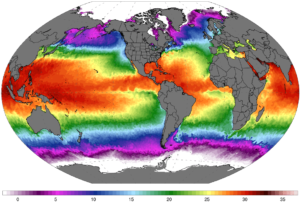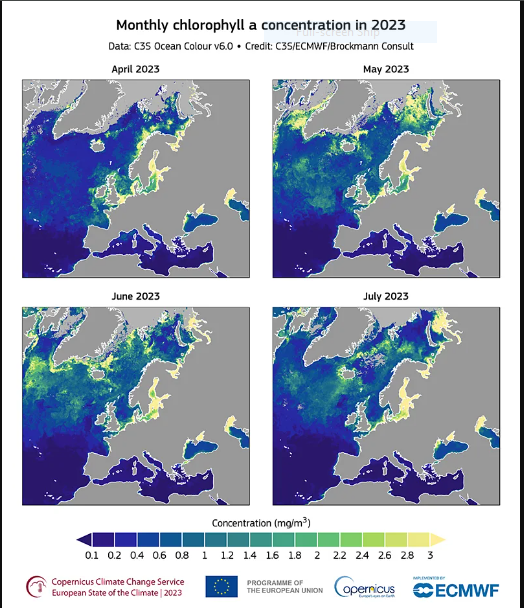Physical Address
23,24,25 & 26, 2nd Floor, Software Technology Park India, Opp: Garware Stadium,MIDC, Chikalthana, Aurangabad, Maharashtra – 431001 India
Physical Address
23,24,25 & 26, 2nd Floor, Software Technology Park India, Opp: Garware Stadium,MIDC, Chikalthana, Aurangabad, Maharashtra – 431001 India

Rising temperatures contribute to the coral bleaching, in the South Pacific, May 2019. Pic courtesy: Alexis Rosenfeld
By G.R. Diwyanjalee
As our planet continues to warm, the oceans, which cover 70% of Earth’s surface, are absorbing a significant amount of this heat. This phenomenon has far-reaching implications for marine ecosystems and global climate patterns. This article delves into the causes, regional variations, and ecological impacts of rising ocean temperatures, supported by expert insights and recent research.
Reasons for Ocean Temperature Rising
Since the Industrial Revolution, human activities such as burning fossil fuels and deforestation have significantly increased greenhouse gas emissions, primarily carbon dioxide. These gases trap heat in the atmosphere, with only about 1% staying in the air. The remaining 99% is absorbed by the oceans, leading to a gradual increase in ocean temperatures.
According to Alejandra Borunda, National Geographic Society, ‘The top part of the ocean is warming about 24% faster now than it did a few decades ago, and that rate is likely to increase in the future.’ This highlights the accelerating pace of ocean warming.
Daily mean Sea Surface Temperature (SST) from NOAA Optimum Interpolation SST (OISST) version 2.1, illustrating temperature fluctuations across different ocean regions, Source: Climate Reanalyzer
According to NASA, approximately 90% of global warming is absorbed by the oceans, with the top few meters holding as much heat as Earth’s entire atmosphere.
However, research by D.E. Harrison and Mark Carson (2007) highlights substantial spatial variability in upper-ocean temperature trends since 1950, with some regions experiencing cooling exceeding 3°C while others warming equally. This variability underscores the complexity of regional temperature changes over decades, suggesting shorter-term trends may not fully represent long-term trends.
Regional Variations in Sea Surface Temperature. Source: Climate Reanalyzer
Global Ocean Temperature Fluctuations
NASA Climate Change: “With 70% of the planet covered by water, the seas are important drivers of Earth’s global climate. Yet, increasing greenhouse gases from human activities are altering the ocean before our eyes.”
NASA recently highlighted this concern with a visual representation on Instagram, showing the impact of greenhouse gases on Earth’s water bodies. Ocean warming is not uniform across the globe. Factors such as ocean currents, geographical location, and seasonal variations influence regional temperature changes. NASA’s Estimating the Circulation and Climate of the Ocean Phase II (ECCO2) model provides detailed visualizations showing these variations. Warmer colors (red, orange, yellow) in NASA’s data represent increased temperatures, while cooler colors (green, blue) indicate lower temperatures.
/div>
Dynamic sea surface currents depicted with color-coded sea surface temperatures, captured between 2007-2008. Explore more at svs.gsfc.nasa.gov/3912.
From the data, it’s evident that the first 2,000 meters of ocean depth have experienced significant warming since 1955; global ocean heat content has increased by 360 ± 2 zettajoules, with the last decade being the warmest on record. This rise in temperature is not uniform, with regions near the equator becoming significantly greener, indicating shifts in marine ecosystems.
Impact on Marine Ecosystems
Rising ocean temperatures have profound implications for marine ecosystems:
Bleached coral off Islamorada, Florida. Pic courtesy: Kelsey Roberts/USGS
A marine heatwave off the west coast of Australia decimated kelp populations, dramatically affecting the local marine ecosystem. (Pic courtesy: Thomas Wernberg).
Satellite image of Hurricane Humberto, west of Bermuda, September 2019. Rising ocean temperatures in the region have more than doubled hurricane maximum wind speeds in the subtropical Atlantic around Bermuda over the last 60 years. Pic courtesy: NOAA
Iceberg Melting in Antarctic Waters: Climate Change Accelerates Ice Loss. Pic courtesy: Paul Nicklen, NAT GEO IMAGE COLLECTION
Jennifer Chu, MIT News Office: “The ocean’s color has changed significantly over the last 20 years, reflecting significant shifts in essential marine ecosystems due to human-induced climate change.”
Climate-driven changes in phytoplankton communities will intensify the blue and green regions of the world’s oceans, altering marine ecosystems and impacting global carbon cycles. Pic courtesy: NASA Earth Observatory
B. B. Cael, National Oceanography Center: “The color changes we observe are not a random variation in the Earth system. This is consistent with anthropogenic climate change.”

Huge concentrations of chlorophyll in warming waters around Europe in 2023, indicating significant shifts in marine ecosystems. Pic courtesy: Copernicus Climate Change Service
Therefore, As NASA’s visualization starkly shows, our oceans are changing, and so must our efforts to protect and preserve them. The rising temperatures of our oceans serve as a stark reminder of the urgent need to combat climate change. The impacts on marine ecosystems and global weather patterns are profound and far-reaching. It is crucial for policymakers, scientists, and the public to work together in mitigating these effects and preserving our planet’s health for future generations
Comments are closed.
ZhQjOAIficBK